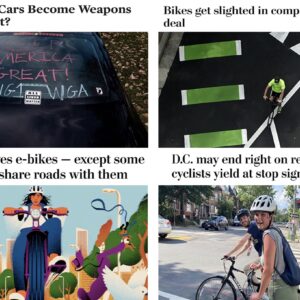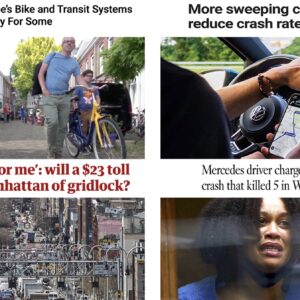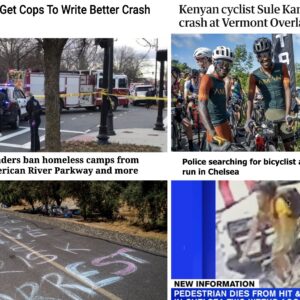“…although traffic accidents remain a major public safety problem, the biggest killer of people ages 5 to 34, vehicle travel is far safer than it was a few decades ago.”
— The New York Times
Here’s the news and other interesting stuff that caught our eyes this past week…
– The Wall Street Journal takes a look at how “Bicyclists of a Feather Flock Together” in their article based on a new book about the subject of “bike tribes.”
– It’s been a few months since the reauthorization of MAP-21, the national transportation legislation, but our story on the implications of giving local roads over to federal control is creating national concern about the impact of federal road design standards, and some people are asking whether or not it makes sense to have federally controlled transportation projects at all.
– An analysis by the New York Daily News says the delay to New York City’s bike share system is a “blessing in disguise” that will give the city time to further build its network of bicycle infrastructure but also suggests the city should cancel the current contract with Alta Bike Share and restart the search for a bike share provider.
– Excitement (and sponsor support) is already building for the 2012 cyclocross World Championships in Louisville, Kentucky. It will be the first time the event is held outside of Europe. The US ‘cross season got underway last week with Cross Vegas, where Jeremy Powers of the Portland-based Rapha/Focus squad took home top honors.
– Brussels, the capital of the European Union, recently banned cars from most city streets for one whole day as part of their celebration of European Mobility Week.
– Brussels isn’t the only major European city looking to curtail automobile traffic. Aljazeera takes a look at the effort by the Mayor of Paris who is working to ban motorized traffic on major roads to try and make the city more livable.
– One bicycle helmet supplier is on the defensive after a lawyer claimed they misrepresented the dangers of riding a bicycle in order to help retailers sell more helmets.
– An open letter to Interbike criticizing the convention’s outreach to women who ride bikes includes a nod to Elly Blue’s Bike Test.
– Data from the Los Altos Bicycle Transportation Plan (created by Portland-based Alta Planning) shows a bias in the Police definition of “fault” in collisions involving bicycles.
– The Wall Street Journal looks at new types of traffic signals including a number pioneered here in Portland.
– And while new traffic signals are introduced, there are some old, redundant traffic signs that could use some standardization.
– The story of a reformed “scofflaw” explains why some people get so worked up when they see people break the law on bicycles when they shouldn’t.
– Also from Slate, an excellent explanation of why people have a (misplaced) “hatred of cyclists.”
– A man has been ticketed after being accused of harassing two men on bicycles by excessively blaring a car’s horn at them, an act which was caught on video by one of the men riding a bike.
– There’s a new smartphone app that automatically replies to text messages and mutes the distracting sounds of a phone while a person is driving.
– A new online service wants to make peer-to-peer bike rentals easier.
– The New York Times has an interesting graph plotting trends in vehicle miles driven versus auto fatalities from 1950 through last year.
– Graem Obree is hoping to set a record by traveling at 100mph on a pedal-powered bicycle and the physics of the stunt stack up in his favor.
– Washington DC’s bike share system celebrated its second anniversary recently as membership and number of trips taken on Capital Bikeshare continue to grow.
– A driver in a hit-and-run collision in the UK was more concerned about dents in their car than about a schoolboy’s safety according to witnesses.
– Check out the concept for this elevated “veloway” superhighway in Melbourne, Australia:
– Again from Brussels, there’s a great documentary on bicycle messengers in the Belgian city:
Brussels Express from Sander Vandenbroucke on Vimeo.
– Say what you want about Mitt Romney’s politics, his new plan features bike manufacturers as an example of small business in America:
— Did you find something interesting that should be in next week’s Monday Roundup? Drop us a line. For more great links from around the web, follow us on Twitter @BikePortland.





Thanks for reading.
BikePortland has served this community with independent community journalism since 2005. We rely on subscriptions from readers like you to survive. Your financial support is vital in keeping this valuable resource alive and well.
Please subscribe today to strengthen and expand our work.
I could feel my blood pressure go up while watching the video of the truck harassing the two cyclists.
I almost didn’t watch it because I knew it’d get me riled. I wonder if the Friel who took the video is related to Joe Friel, cycling scientist and training expert?
Glad the driver got a ticket. In some places I’ve ridden he’d have gotten a pat on the back.
I believe they are the same person.
More and more cities here in California are passing anti-harassment ordinances to address behavior like this. Sunnyvale is one: http://bikesiliconvalley.org/2012/06/sunnyvale-passes-anti-harassment-ordinance. About a month ago I was harassed by a driver who let off the brake and rolled into my back wheel, which was a pretty stupid move because 1) I snapped a quick photo of his license plate pushed against me, and 2) he was in a well-marked company car. Upon speaking with the GM of his (Sunnyvale-based) company I learned he (the GM) was an avid roadie and local MTB coach who had just returned from lunch with the Sunnyvale mayor discussing the ordinance. Karma…
while the study ALTA did for Los Altos probably does show police bias in reporting fault in car/bike collisions, the example they gave in the narrative is not persuasive. if you are flying down a hill at a speed that does not allow you to take evasive action if someone comes in from a side street, you are in fact going too fast for conditions, i don’t care what the posted limit is.
And if someone does not yield to you as the through traffic, you are not (primarily) at fault. That was the point. The officers are holding the cyclists at fault for the drivers that are failing to yield to the through traffic.
I had exactly this happen to me in downtown Portland 5 years ago. A driver rolled a red for a right turn, right in front of me as I went through on a green. And accident happened. One witness claimed I was speeding (a physical impossibility BTW) and the insurance adjuster (at first) took it to heart that I was equally responsible for causing the accident. Until it was driven into her head that he had run a red light and failed to yield to through traffic (me!) I was at risk of being liable for his paint damage.
You are wrong. We have a thing called “failure to yield” for a reason.
and they do list the stats for that on the same table, and the numbers there show motorists primarily at fault. and i agree the numbers across the table do seem to reflect a bias against cyclists, though when you see fourteen of fifty-seven instances involving a cyclist on the wrong side of the road maybe there is actually a problem.
my point was that the narrative selected to illustrate the speeding/not speeding issue was not persuasive. a bicyclist doing thirty downhill on a road that someone might conceivably enter or merge into is taking a calculated risk that simply might not pan out. surely they could have used a more persuasive example.
unless that really is where the sixteen figure comes from, in which case again, i think there may be a problem.
That intersection noted is completely flat. http://goo.gl/maps/rvqoy
then the example is exceptionally poorly chosen. why would you be going thirty through a signalized intersection with four lanes in each direction? if the example is based on actual incidents, this should be mentioned.
As I mentioned, the example is the reality of Foothill in Los Altos. There is no law against me going 30 MPH through a signalized intersection, and when I’m accompanied by traffic to my left legally doing 45 MPH I do it quite frequently here. If anything I want to be doing 25+ MPH through these intersections as I’m less likely to be a victim of the intentional unsafe pass that the narrative is based on. I’m willing to bet in most of the cases on record the driver was so focused on beating the cyclist to the corner they failed to notice the other reality of Foothill: traffic around the corner is stopped.
Also the third reality on Foothill is if I’m not doing 30 MPH through the green light I’ll be sitting there for a long time (like the roadie in the image). 🙂
I totally disagree. That is not the legal standard.
are, I see your point, but I ride Foothill frequently and there are a few infamous merges that give the writer reason for that particular narrative. He’s not writing about a cyclist ‘coming out of nowhere’ down a hill to hit the side of a car, he’s referring to the very common scenario of drivers racing to beat cyclists to the splits (i.e. San Antonio). Motorists here in Silicon Valley are generally quite courteous and attentive (maybe because of a high cycling population) but at these intersections some people tend to be very aggressive at cutting off cyclists instead of properly merging behind (a girl was killed a few years ago at Loyola Corners). Foothill is a mostly flat road with wide buffers and is VERY popular year-round with cyclists/triathletes (it feeds Old La Honda and other great climbs and passes to the coast). Drivers tend not to speed on it either, as the (notoriously strict) Los Altos police frequently patrol and enforce Foothill. (Los Altos Hills, mind you, is one of the wealthiest communities in the country).
I’ve made it a habit of taking the lane in a few select intersections there. I have a saying: I don’t take chances, I take lanes.
A month ago (Sunday morning, light traffic) I was doing maybe 30 on Foothill during a sprint interval and came up on a green light where a white BMW was slowing to a stop. Without warning he started to turn in front of me, I screamed, turned hard and slid the bike almost into him, and if it wasn’t for the “cyclist” and his wife sitting in the back seat who saw me I’d have kissed his hood quite hard (we spoke later, civilly). He was turning right (without looking or signalling) where it is clearly marked “No Right Turn.” (He misread directions to a wedding and missed the previous right turn). I’m willing to bet if the crash had happened it would have been written up to me traveling too fast (it’s happened to a few of my club buddies there).
That graph in the NyTimes article is pretty amazing. Definitely worth a click.
Agreed. Very interesting. Though I’m not sure I agree entirely with the conclusion in the discussion of the graph:
“You see fatalities drop after a breakthrough in new technologies or behaviors, and then plateau until the next one,”
What stood out for me in the graph was something else. Every time the rate at which driving per capita stopped increasing we see coincident periods during which the fatality rate declined.
And the opposite was equally striking: Every time the rate of driving per capita resumed its upward trend, the fatality rate stopped declining.
Look at these four periods:
chg in fatalities chg in p.c. mi trvld
’73-’75 -20% 0
’80-’83 -18% +1%
’88-’92 -20% +2%
’04-’11 -40% -6%
The explanatory sidebars in the article purporting to explain the safety features that coincided with the drops in fatality in no way explain the interruption of the increase in distance traveled that coincides with every single one of these periods. What is causing people to stop driving more? and what does this interruption have to do with safety? Put another way, why would safety features (if that is a causal factor) align with steady rates of driving per capita?
Most of those periods listed above, during which driving became safer and people’s driving quantity stayed constant also coincide with periods of economic decline or the absence of economic confidence, so measured. Is this a variant on Hans Monderman’s insight about removing traffic signage? Greater uncertainty/insecurity = more cautious driving?
Will, perhaps you need to send the Wall Street Journal a copy of this post to show them what cyclocross actually is. I found the aerohelmet and aerobar positioning to be especially humorous.
I would also love if they wrote the same article about weekend warrior motorcycle riders culture (with appropriate “eye-popping” price tags).
Articles like that are just derogatory and sad.
It’s the WSJ…
I would just like to highlight Jim Saksa’s (the “scofflaw”) Slate article as something I think many Bike Portland conversations could benefit from.
The WSJ story draws attention to PDX cycling culture through humorously creating tribes where stereotypes are gently poked fun. Cycling specific Portlandia. It’s not going to depict each discipline with absolute accuracy… it’s all for fun, much like cyclocross. I, for one, am anxiously awaiting to get muddy this season.
It would be fun if they didn’t have price tags listed for everything in the article. That is what makes it kind of ridiculous: “Look how much these crazy cyclists spend on biking gear”.
WSJ article is an out and out rip off of Bike Snob’s first book.
the video of the cyclists harassed by the SUV didn’t show the driver’s face…
in Oregon we can issue a citizen citation only if we get a look at their face…
would we be able to submit video evidence to the police and expect them to pursue charges in such a case? and if so, how serious do the charges have to be? menacing and harassment? or just traffic violation?